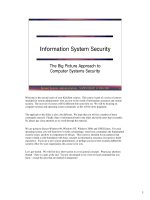Information system ralph CH08
Bạn đang xem bản rút gọn của tài liệu. Xem và tải ngay bản đầy đủ của tài liệu tại đây (582.13 KB, 73 trang )
Fundamentals of Information
Systems, Fifth Edition
Chapter 8
Systems Development
Principles and Learning Objectives
• Effective systems development requires a team
effort of stakeholders, users, managers, systems
development specialists, and various support
personnel, and it starts with careful planning
– Identify the key participants in the systems
development process and discuss their roles
– Define the term information systems planning and
discuss the importance of planning a project
Fundamentals of Information Systems, Fifth Edition
2
Principles and Learning Objectives
(continued)
• Systems development often uses different
approaches and tools such as traditional
development, prototyping, rapid application
development, end-user development, computeraided software engineering, and object-oriented
development to select, implement, and monitor
projects
– Discuss the key features, advantages, and
disadvantages of the traditional, prototyping, rapid
application development, and end-user systems
development life cycles
Fundamentals of Information Systems, Fifth Edition
3
Principles and Learning Objectives
(continued)
– Discuss the use of computer-aided software
engineering (CASE) tools and the object-oriented
approach to systems development
• Systems development starts with investigation and
analysis of existing systems
– State the purpose of systems investigation
– Discuss the importance of performance and cost
objectives
– State the purpose of systems analysis and discuss
some of the tools and techniques used in this phase
of systems development
Fundamentals of Information Systems, Fifth Edition
4
Principles and Learning Objectives
(continued)
• Designing new systems or modifying existing ones
should always be aimed at helping an organization
achieve its goals
– State the purpose of systems design and discuss the
differences between logical and physical systems
design
– Discuss the issues involved in environmental design
– Define the term RFP and discuss how this document
is used to drive the acquisition of hardware and
software
Fundamentals of Information Systems, Fifth Edition
5
Principles and Learning Objectives
(continued)
• The primary emphasis of systems implementation
is to make sure that the right information is
delivered to the right person in the right format at
the right time
– State the purpose of systems implementation and
discuss the various activities associated with this
phase of systems development
Fundamentals of Information Systems, Fifth Edition
6
Principles and Learning Objectives
(continued)
• Maintenance and review add to the useful life of a
system but can consume large amounts of
resources, so they benefit from the same rigorous
methods and project management techniques
applied to systems development
– State the importance of systems and software
maintenance and discuss the activities involved
– Describe the systems review process
Fundamentals of Information Systems, Fifth Edition
7
An Overview of Systems Development
• Corporations and nonprofit organizations
– Use systems development to achieve their goals
• First Health of the Carolinas
– Upgraded old imaging system to slash costs and
provide better health care for patients
– Reduced costs by more than 30 percent
– Offered doctors better radiological images to improve
patient care
Fundamentals of Information Systems, Fifth Edition
8
Participants in Systems Development
• Development team
–
–
–
–
–
Project managers
Stakeholders
Users
Systems analysts
Programmers
Fundamentals of Information Systems, Fifth Edition
9
Fundamentals of Information Systems, Fifth Edition
10
Information Systems Planning and
Aligning Corporate and IS Goals
• Information systems planning
– Translating strategic and organizational goals into
systems development initiatives
• Aligning corporate and IS goals
– Critical for any successful systems development
effort
– IS plan should guide development of the IS
infrastructure over time
Fundamentals of Information Systems, Fifth Edition
11
Fundamentals of Information Systems, Fifth Edition
12
Fundamentals of Information Systems, Fifth Edition
13
Systems Development Life Cycles
• The systems development process
– Also called systems development life cycle (SDLC)
• The life of the system continues as it is maintained
and reviewed
Fundamentals of Information Systems, Fifth Edition
14
The Traditional Systems Development
Life Cycle
•
•
•
•
•
Systems investigation
Systems analysis
Systems design
Systems implementation
Systems maintenance and review
Fundamentals of Information Systems, Fifth Edition
15
Fundamentals of Information Systems, Fifth Edition
16
Prototyping
• Takes an iterative approach to the systems
development process
• Begins with creating a preliminary model of a major
subsystem or a scaled-down version of the entire
system
Fundamentals of Information Systems, Fifth Edition
17
Fundamentals of Information Systems, Fifth Edition
18
Rapid Application Development, Agile
Development, Joint Application
Development, and Other Systems
Development Approaches
• Rapid application development (RAD)
– Employs tools, techniques, and methodologies
designed to speed application development
• Joint application development (JAD)
– A process for data collection and requirements
analysis
– Originally developed by IBM Canada in the 1970s
Fundamentals of Information Systems, Fifth Edition
19
The End-User Systems Development
• Any systems development project in which
business managers and users assume the primary
effort
• Managers and other users can get the systems
they want without having to wait for IS
professionals to develop and deliver them
Fundamentals of Information Systems, Fifth Edition
20
Outsourcing and On-Demand
Computing
• Reasons for using outsourcing and on demand
computing
–
–
–
–
Reducing costs
Obtaining state-of-the-art technology
Eliminating staffing and personnel problems
Increasing technological flexibility
Fundamentals of Information Systems, Fifth Edition
21
Use of Computer-Aided Software
Engineering (CASE) Tools
• Computer-aided software engineering (CASE) tools
– Automate tasks required in a systems development
effort and encourage adherence to the SDLC
• Upper-CASE tools
– Focus on activities associated with the early stages
of systems development
• Lower-CASE tools
– Focus on the later implementation stage of systems
development
Fundamentals of Information Systems, Fifth Edition
22
Fundamentals of Information Systems, Fifth Edition
23
Fundamentals of Information Systems, Fifth Edition
24
Object-Oriented Systems
Development
• Combines the logic of the systems development life
cycle with the power of object-oriented modeling
and programming
• Follows a defined systems development life cycle,
much like the SDLC
Fundamentals of Information Systems, Fifth Edition
25









